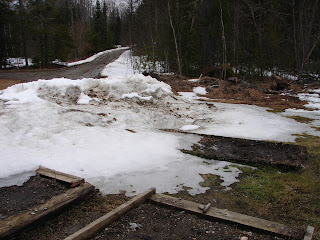
As for me, I love them and plant them in my garden every year. But
instead of harvesting them in fall, along with carrots, my parsnips spend the
fall and winter in the ground. This greatly increases their sugar content.
Then, the following spring when the ground thaws, my parsnips are extra-sweet
and delicious.
And right now in late March, it’s time to pull my parsnips. But I can’t, because they are covered by a huge pile of snow. My garden plot makes a convenient place for the snow plow man to use as a “push-off,” or place where he can dump loads of snow after making a long, straight run. I’ve tried to discourage him from this habit, but he has a standard retort. “I’ve got nowhere else to put it.” It’s hard to argue with that kind of logic.
So my parsnips remain out-of-bounds for the foreseeable future, so near and yet so far.
On to another garden vegetable topic, I recently checked out Mike Webber’s blog in the online version of the Bangor Daily News. There, I saw a familiar-looking photo, along with a title that said something about due apologies to Tom. I clicked on the header and went to the full-length blog.
Mike had read one of my past blogs, one that I had named, “Chives Alive.” Mike posted a photo of his own chive patch, with the little green onion-like tops poking up out of newly-thawed ground. “Chives Arrive,” he called his post, thus the apology to me.
Mike, if you read this, you must know that I consider imitation the sincerest form of flattery. You go ahead and copy me any time. I’m honored.
By the way, Mike, did you plant parsnips last year and leave them in the ground all winter, as I did? If so, are you able to pull them yet?
Here’s to all of us who dearly want for winter to go away for good. Let’s agree that sunny, warmer days lie just ahead. And of course, if anyone wants to keep in shape by shoveling snow, I know of a big pile of it that needs removing.
